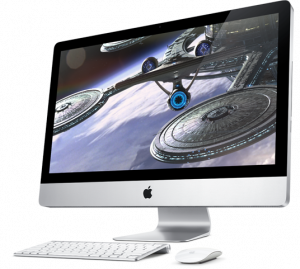I’ve been using an iMac in my house for years. It’s become one of my favorite computers and the new model only strengthens the reasons why I’ve come to depend on it.  I’m using the 27-inch model with a 3.06GHz Intel Core 2 Duo processor, 4GB Ram and a 3MB L2 Cache. That all adds up to power and speed, which is important whether you’re a home user, small business user or even something like a professional musician.
I’m using the 27-inch model with a 3.06GHz Intel Core 2 Duo processor, 4GB Ram and a 3MB L2 Cache. That all adds up to power and speed, which is important whether you’re a home user, small business user or even something like a professional musician.
Targeting a computer to the home market these days does not mean it doesn’t have to be powerful. The home users are becoming the new power users and the computers have to live up to those expectations.
With iLife included free on every computer, applications like iPhoto, iMovie, iTunes, iWeb, GarageBand and iDVD are being used everyday to create multimedia that’s being shared among friends and family around the world.
Years ago, when iLife was first introduced and Steve Jobs talked about the digital shoebox, users may have had a few hundred pictures and songs on their computers. However, these days the numbers are in the thousands or even tens of thousands.
My new iMac is running an iTunes library with 3097 songs, an iPhoto library with 13,922 photos and movies, and a movie folder with countless iMovie film clips dating back to 2003.
iTunes opens instantly and is ready to play. iPhoto takes about five seconds and iMovie about 10 seconds. That’s pretty good for a consumer machine. My iMac can be upgraded with an additional 12GB of Ram, so there is still some room to improve performance once the apps are up and running.
It’s hard to knock the design of the iMac. I’m not one of those that thinks Apple needs to come out with a new design every year. The current design is beautiful sitting on the desk, fits in with almost any decor, and is very functional. Why change?
With its new wireless Magic Mouse (see separate review) and keyboard, the ports are available for other accessories. The iMac comes with one FireWire 800, four USB 2.0 and an SD card slot.
The SD card slot is right under the optical drive on the side of the iMac. It’s a convenient spot that doesn’t take away from the aesthetics of the computer.
The keyboard is one of the smaller models that doesn’t have the number pad on the right hand side. Personally, I like to have the number pad, but I use it mostly for Logic and Pro Tools — the rest of my family likes the smaller model. I guess it depends on your use.
Of course, the iMac is also decked out with networking options. It has built-in 802.11n wireless networking, Bluetooth 2.1 EDR and Ethernet, so you are pretty much covered with whatever you want to do.
Apple’s improvements of the iMac continue to make this one of the most desirable computers on the market. Whether you’re at home, work or using it for a creative profession, the iMac will not let you down.
